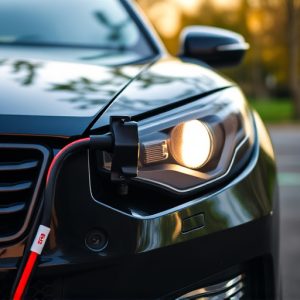Boat Battery Basics: A Beginner’s Guide to Installation and Selection
A boat battery is a critical component for any mariner, providing essential power for engines and electronic systems. Understanding the different types of boat batteries—lead-acid, AGM, and lithium—and their specific advantages and maintenance requirements is crucial. Lead-acid batterie…….

A boat battery is a critical component for any mariner, providing essential power for engines and electronic systems. Understanding the different types of boat batteries—lead-acid, AGM, and lithium—and their specific advantages and maintenance requirements is crucial. Lead-acid batteries are reliable but require more maintenance; AGM batteries are spill-proof and maintenance-free with better performance in extreme temperatures; and lithium batteries offer high energy density, longer lifespans, and greater resistance to deep discharges, though they demand proper charging equipment. When selecting a boat battery, consider its ampere-hour (Ah) rating for sustained power needs, cold cranking amps (CCA) for cold starting, and resistance to vibration and shock. Proper installation, regular upkeep like terminal cleaning and electrolyte checking, and understanding the battery's capacity in relation to your boat's electrical demands are essential for optimal performance and longevity. Selecting the right battery type and size ensures that your vessel's electronic systems function smoothly, enhancing safety and the overall boating experience. Remember to match the battery's physical dimensions and terminal types with your boat's system to ensure compatibility and peak performance. With the right knowledge and selection, a boat battery will be a dependable source of power for all your maritime endeavors.
Embark on a journey to master the art of installing and maintaining your vessel’s power source with our Beginner’s Guide to Installing Your Boat Battery. This comprehensive guide delves into the essentials of maritime electricity, from understanding the distinct types of boat batteries—Lead-Acid, AGM, and Lithium—to selecting the most suitable one for your nautical adventures. We outline the key features that distinguish each type, ensuring you make an informed decision tailored to your boating needs.
Before you set sail on the installation process, we provide critical safety tips and a checklist of tools and materials necessary for a hassle-free experience. Learn how to determine the optimal location for your battery, considering ampere hours and capacity, to maximize performance and convenience.
Our step-by-step guide walks you through every aspect of installing a boat battery, from removing the old unit with care to securing and fastening the new one in place. We also cover the intricacies of connecting your battery to the electrical system, emphasizing safety and proper ventilation.
To keep your investment running smoothly, we share daily maintenance tips, explain charging systems, and offer advice on regular checks for monitoring battery health. Additionally, we guide you through winterizing your battery and address common issues that may arise with marine batteries. Recognizing when it’s time to upgrade is crucial, and our article will equip you with the knowledge to do so confidently. Set sail with confidence by harnessing the power of a well-installed and maintained boat battery—your vessel’s silent captain.
- Understanding Boat Batteries: The Basics for Beginners
- – The Role of a Boat Battery in Maritime Operations
- – Types of Boat Batteries: Lead-Acid vs. AGM vs. Lithium
- – Key Features to Look For in a Boat Battery
Understanding Boat Batteries: The Basics for Beginners

When embarking on a maritime adventure, understanding your boat battery is paramount for ensuring reliable power on the water. Boat batteries differ from automotive counterparts due to their exposure to variable conditions such as temperature fluctuations and humidity. These marine batteries are specifically designed to withstand such environments while providing the necessary energy for starting engines, running electronics, and lighting. For beginners, it’s crucial to recognize that there are two primary types of boat batteries: starting (or SLI) batteries and deep-cycle batteries. Starting batteries are optimized for short, high-current demands like cranking an engine, while deep-cycle batteries are designed for sustained use, such as trolling or powering onboard systems over extended periods.
To maximize the lifespan and performance of your boat battery, proper maintenance and understanding of its operation are essential. Regularly check and maintain appropriate charge levels to prevent sulfation, a common issue that impairs battery efficiency. Additionally, ensure that the battery is securely mounted to prevent movement that can lead to internal damage. When connecting batteries for additional capacity or redundancy, use proper wiring techniques to avoid electrical issues that could endanger crew and vessel. Understanding the voltage requirements of your boat’s equipment will help you select the correct battery size and type, ensuring compatibility and reliability on your journeys. Regular cleaning, topping off electrolyte levels as necessary, and inspecting terminals for corrosion are routine tasks that contribute to the longevity and health of your boat battery. With this foundational knowledge, beginners can confidently navigate the complexities of boat battery systems and maintain their boats’ power needs effectively.
– The Role of a Boat Battery in Maritime Operations

A boat battery plays a pivotal role in maritime operations, serving as the power source for various onboard systems, from navigation equipment to fish finders and depth sounders. Its function extends beyond starting the engine; it ensures that all 12-volt electrical components function when the vessel is underway or at rest. For beginners, understanding the importance of a boat battery and its proper installation is crucial for seamless sailing experiences. The battery must be compatible with the boat’s electrical system and designed to withstand the harsh marine environment, which includes resisting corrosion from saltwater and enduring fluctuations in temperature. When installing a new boat battery, it’s imperative to follow manufacturer guidelines closely. This involves selecting the correct size and type for your vessel, securing the battery properly to prevent movement that could cause damage or short-circuiting, and ensuring all connections are tight and free of corrosion for optimal performance and longevity. Additionally, proper ventilation and insulation are necessary to protect both the battery and the boat’s occupants from potential hazards. With a correctly installed boat battery, mariners can rely on their vessel’s electronic systems, enhancing safety and enjoyment on the water. Regular maintenance and understanding how to recharge or replace the battery as needed will further ensure that your boat’s power source remains reliable throughout your maritime endeavors.
– Types of Boat Batteries: Lead-Acid vs. AGM vs. Lithium

When it comes to powering your vessel, selecting the right boat battery is crucial for both performance and longevity. There are three primary types of boat batteries available on the market today: lead-acid, Absorbent Glass Mat (AGM), and lithium. Each type has its own set of characteristics that make it suitable for different boating needs.
Lead-acid batteries have been the traditional choice for marine applications for many years. They are known for their reliability and affordability but tend to be heavier and require more maintenance than their modern counterparts. These batteries work well for short trips and minimal use, as they can often handle a few deep discharges without significant negative effects.
Advancing from the traditional lead-acid technology, AGM boat batteries offer a spill-proof design with improved performance. They are sealed and maintenance-free, making them ideal for those who prefer an easy and trouble-free solution. AGM batteries hold more charge than standard lead-acid types and can perform better in extreme temperatures. Their robust construction makes them resistant to vibration and shocks, which is a common occurrence on boats.
On the cutting edge of marine battery technology, lithium boat batteries are becoming increasingly popular due to their high energy density, lightweight design, and long lifespan. These batteries provide consistent performance across a wide range of temperatures and can be charged or discharged at higher rates without loss of battery life or capacity. Lithium options are also more compact than traditional lead-acid batteries, offering boat owners the chance to increase storage space or improve the boat’s overall weight distribution. When installing a lithium battery, it’s important to ensure proper charging equipment and possibly additional safety features due to their higher voltage.
Choosing the right boat battery depends on your specific needs, usage patterns, and budget. Lead-acid batteries are a reliable option for casual users, while AGM batteries offer enhanced performance and convenience. For those seeking the pinnacle of battery technology, lithium boat batteries represent the most advanced solution available in the marine market today.
– Key Features to Look For in a Boat Battery

When selecting a boat battery, it’s crucial to consider several key features that will ensure your marine adventures are powered effectively and reliably. Firstly, evaluate the battery’s ampere-hour (Ah) rating, which indicates the amount of energy the battery can deliver over a given period. A higher Ah rating means more power for longer periods, which is particularly beneficial for trolling or running accessories. Secondly, the type of battery chemistry is vital; lead-acid batteries have traditionally been used in marine applications, but today’s lithium boat batteries offer superior performance with less weight and a greater number of charge/discharge cycles. The cranking ampere (CA) or cold cranking amps (CCA) rating is also important, especially if you navigate in colder climates, as it measures the battery’s ability to start an engine in cold conditions. Additionally, look for a boat battery with vibration and shock resistance, as marine environments can be rough on equipment. Lastly, consider the physical dimensions and terminal types to ensure they are compatible with your vessel’s electrical system. By focusing on these aspects, you can select a boat battery that is well-suited for your nautical endeavors, providing peace of mind and uninterrupted power for all your boating needs.
When venturing into the realm of maritime activities, understanding and properly installing a boat battery is crucial for ensuring smooth operations on the water. This guide has demystified the selection and installation process, highlighting the differences between lead-acid, AGM, and lithium batteries, each with its unique benefits and suitability for various boating needs. With the key features to consider in hand, beginners can now make an informed decision, tailored to their vessel’s requirements and usage patterns. Remember, a well-chosen and correctly installed boat battery is your ship’s silent sentinel, powering everything from navigation systems to fish finders. With this knowledge, you’re equipped to keep your journey on the water safe and enjoyable.







